coolant HONDA ACCORD SEDAN 2001 (in English) User Guide
[x] Cancel search | Manufacturer: HONDA, Model Year: 2001, Model line: ACCORD SEDAN, Model: HONDA ACCORD SEDAN 2001Pages: 372, PDF Size: 6.1 MB
Page 235 of 372
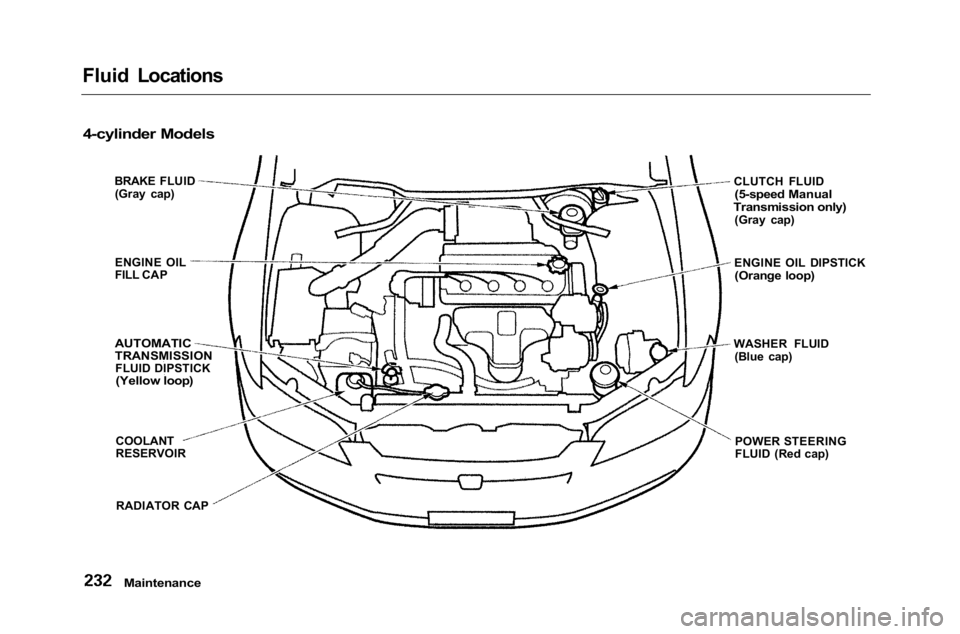
Fluid Locations
Maintenance
4-cylinder Models
BRAKE FLUID(Gray cap)
ENGINE OIL
FILL CAP
AUTOMATIC
TRANSMISSION
FLUID DIPSTICK
(Yellow loop)
COOLANT
RESERVOIR
CLUTCH FLUID
(5-speed Manual
Transmission only)
(Gray cap)
ENGINE OIL DIPSTICK
(Orange loop)
WASHER FLUID (Blue cap)
POWER STEERING
FLUID (Red cap)
RADIATOR CAP
Page 236 of 372
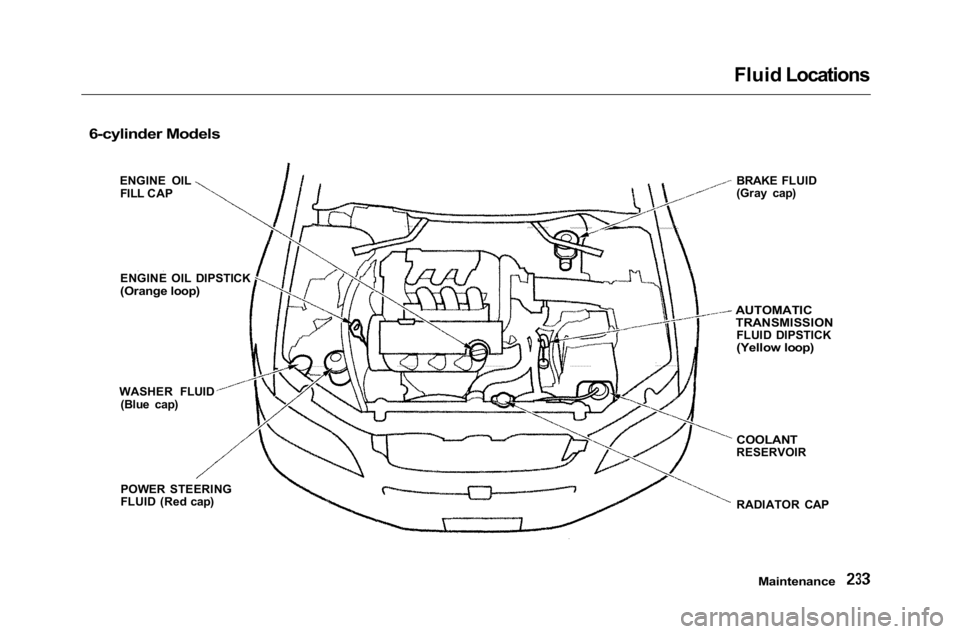
Fluid Locations
Maintenance
RADIATOR CAP
COOLANT
RESERVOIR
AUTOMATIC
TRANSMISSION
FLUID DIPSTICK
(Yellow loop)
6-cylinder Models
ENGINE OILFILL CAP
ENGINE OIL DIPSTICK
(Orange loop)
WASHER FLUID (Blue cap) BRAKE FLUID
(Gray cap)
POWER STEERING
FLUID (Red cap)
Page 242 of 372
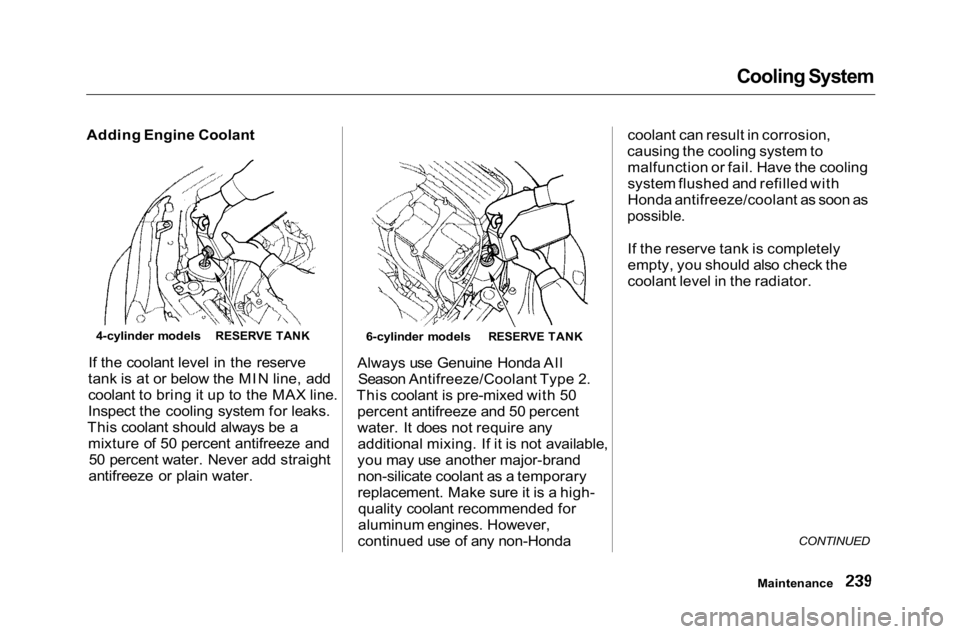
Cooling System
Adding Engine Coolant
If the coolant level in the reserve
tank is at or below the MIN line, add
coolant to bring it up to the MAX line.
Inspect the cooling system for leaks.
This coolant should always be a mixture of 50 percent antifreeze and50 percent water. Never add straight
antifreeze or plain water. Always use Genuine Honda All
Season Antifreeze/Coolant Type 2.
This coolant is pre-mixed with 50 percent antifreeze and 50 percent
water. It does not require anyadditional mixing. If it is not available,
you may use another major-brand non-silicate coolant as a temporary
replacement. Make sure it is a high-quality coolant recommended for
aluminum engines. However,
continued use of any non-Honda coolant can result in corrosion,
causing the cooling system to malfunction or fail. Have the cooling
system flushed and refilled with
Honda antifreeze/coolant as soon as
possible.
If the reserve tank is completely
empty, you should also check the
coolant level in the radiator.
CONTINUED
Maintenance
4-cylinder models
RESERVE TANK
RESERVE TANK
6-cylinder models
Page 243 of 372
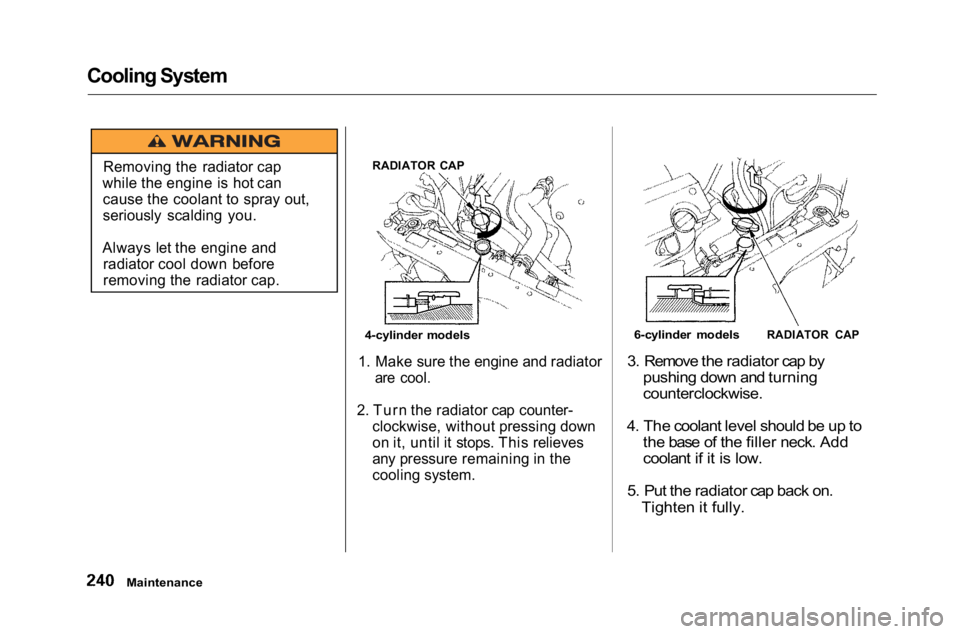
Cooling System
1. Make sure the engine and radiator
are cool.
2. Turn the radiator cap counter- clockwise, without pressing down
on it, until it stops. This relieves
any pressure remaining in the
cooling system.
3. Remove the radiator cap by
pushing down and turning
counterclockwise.
4. The coolant level should be up to the base of the filler neck. Add
coolant if it is low.
5. Put the radiator cap back on. Tighten it fully.
Maintenance
RADIATOR CAP
4-cylinder models 6-cylinder models
RADIATOR CAP
Removing the radiator cap
while the engine is hot can cause the coolant to spray out,
seriously scalding you.
Always let the engine and radiator cool down before
removing the radiator cap.
Page 244 of 372
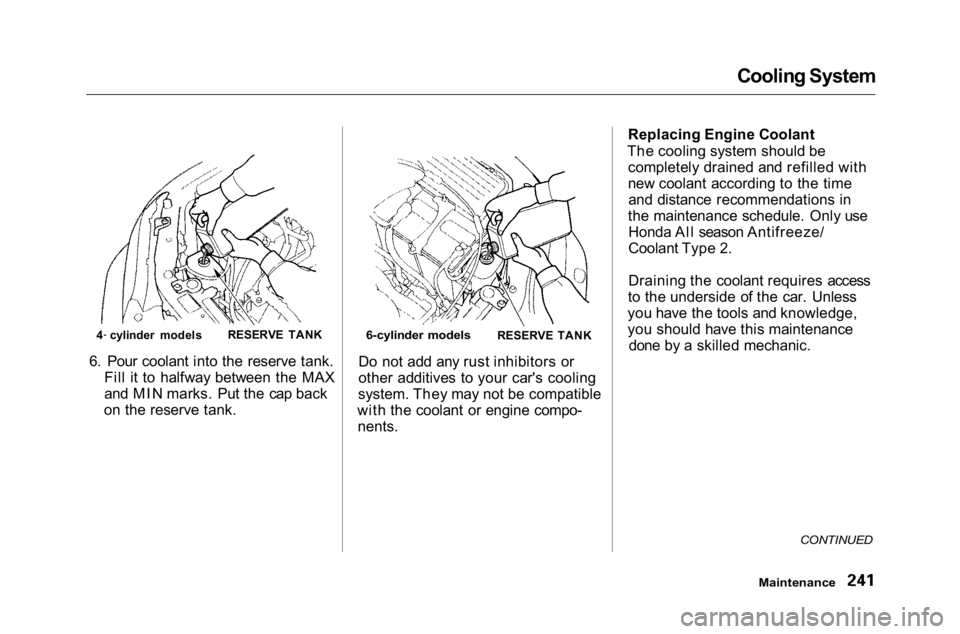
Cooling System
6. Pour coolant into the reserve tank. Fill it to halfway between the MAX
and MIN marks. Put the cap back
on the reserve tank. Do not add any rust inhibitors or
other additives to your car's cooling
system. They may not be compatible
with the coolant or engine compo- nents. Replacing Engine Coolant
The cooling system should be completely drained and refilled with
new coolant according to the timeand distance recommendations in
the maintenance schedule. Only use Honda All season Antifreeze/
Coolant Type 2.
Draining the coolant requires access
to the underside of the car. Unless
you have the tools and knowledge,
you should have this maintenance done by a skilled mechanic.
CONTINUED
Maintenance
4 cylinder models
RESERVE TANK
6-cylinder models
RESERVE TANK
Page 245 of 372
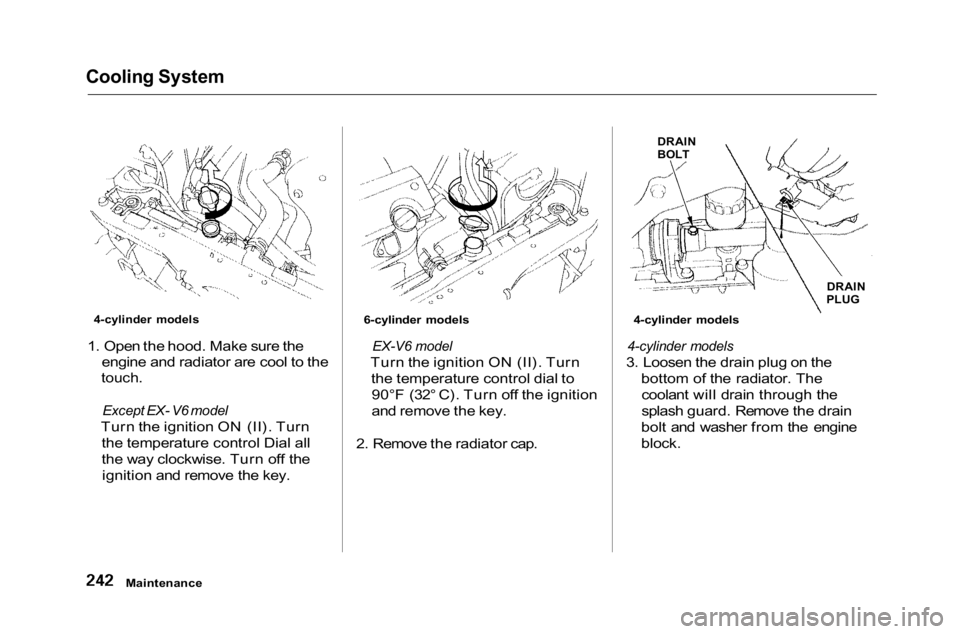
Cooling System
1. Open the hood. Make sure the engine and radiator are cool to the
touch.
Except EX- V6 model
Turn the ignition ON (II). Turn the temperature control Dial all
the way clockwise. Turn off theignition and remove the key.
EX-V6 model
Turn the ignition ON (II). Turn the temperature control dial to90°F (32° C). Turn off the ignition
and remove the key.
2. Remove the radiator cap.
4-cylinder models
3. Loosen the drain plug on the bottom of the radiator. Thecoolant will drain through the
splash guard. Remove the drain
bolt and washer from the engine
block.
Maintenance
DRAIN
BOLT
DRAIN
PLUG
6-cylinder models
4-cylinder models
4-cylinder models
Page 246 of 372
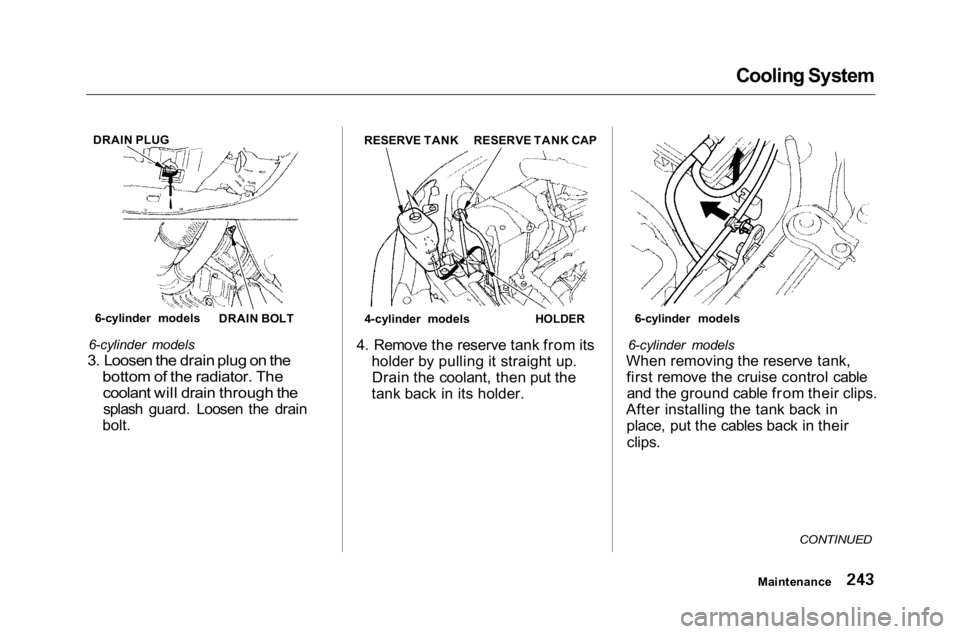
Cooling System
6-cylinder models
3. Loosen the drain plug on the
bottom of the radiator. The
coolant will drain through the
splash guard. Loosen the drain
bolt. 4. Remove the reserve tank from its
holder by pulling it straight up.Drain the coolant, then put the
tank back in its holder. 6-cylinder models
When removing the reserve tank, first remove the cruise control cableand the ground cable from their clips.
After installing the tank back in place, put the cables back in their
clips.
CONTINUED
Maintenance
DRAIN PLUG
RESERVE TANKRESERVE TANK CAP
HOLDER
DRAIN BOLT
4-cylinder models
6-cylinder models
6-cylinder models
Page 247 of 372
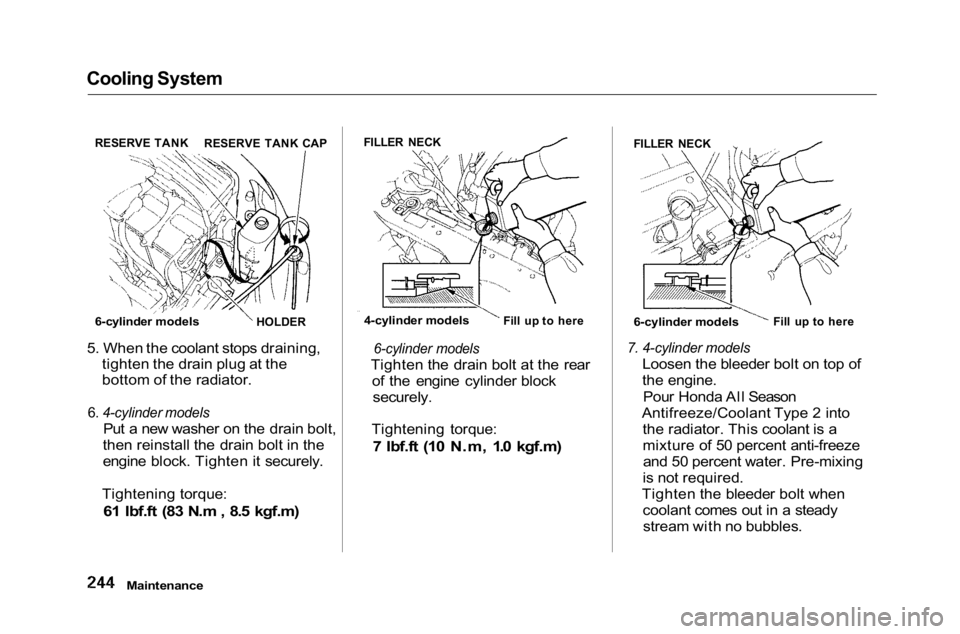
Cooling System
5. When the coolant stops draining, tighten the drain plug at the
bottom of the radiator.
6. 4-cylinder models
Put a new washer on the drain bolt,
then reinstall the drain bolt in the
engine block. Tighten it securely.
Tightening torque:
61 Ibf.ft (83 N.m , 8.5 kgf.m)
6-cylinder models
Tighten the drain bolt at the rear of the engine cylinder block
securely.
Tightening torque:
7 Ibf.ft (10 N.m, 1.0 kgf.m)
7. 4-cylinder models
Loosen the bleeder bolt on top of
the engine.
Pour Honda All Season
Antifreeze/Coolant Type 2 into the radiator. This coolant is a
mixture of 50 percent anti-freezeand 50 percent water. Pre-mixing
is not required.
Tighten the bleeder bolt when coolant comes out in a steadystream with no bubbles.
Maintenance
RESERVE TANK
RESERVE TANK CAP
HOLDER
6-cylinder models 4-cylinder models
Fill up to here
FILLER NECK
FILLER NECK
Fill up to here
6-cylinder models
Page 248 of 372
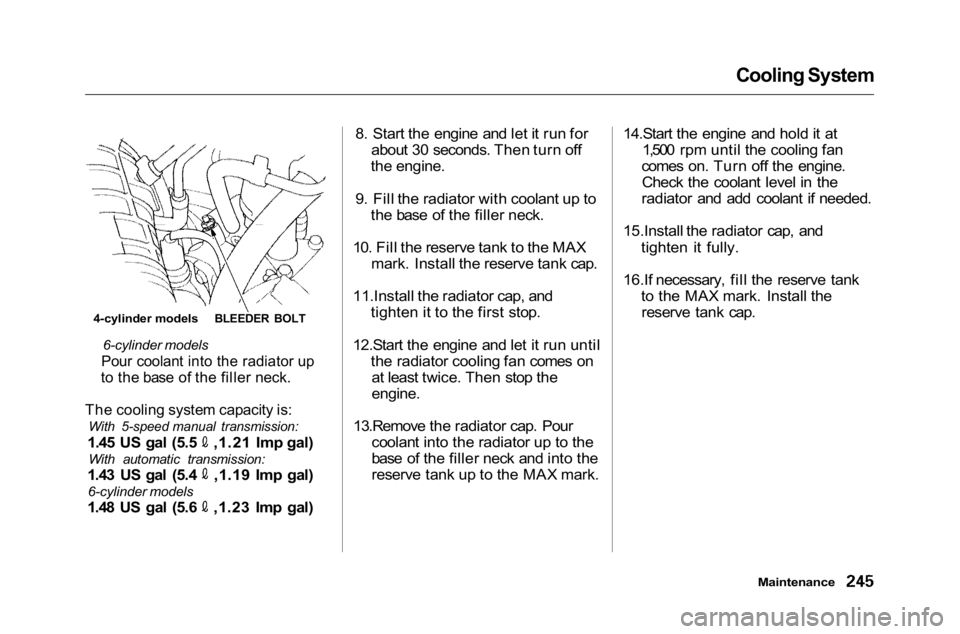
Cooling System
6-cylinder models
Pour coolant into the radiator up
to the base of the filler neck.
The cooling system capacity is:
With 5-speed manual transmission:
1.45 US gal (5.5 ,1.21 Imp gal)
With automatic transmission:
1.43 US gal (5.4 ,1.19 Imp gal)
6-cylinder models 1.48 US gal (5.6 ,1.23 Imp gal) 8. Start the engine and let it run for
about 30 seconds. Then turn off
the engine.
9. Fill the radiator with coolant up to the base of the filler neck.
10. Fill the reserve tank to the MAX mark. Install the reserve tank cap.
11.Install the radiator cap, and tighten it to the first stop.
12.Start the engine and let it run until the radiator cooling fan comes onat least twice. Then stop the
engine.
13.Remove the radiator cap. Pour coolant into the radiator up to the
base of the filler neck and into the
reserve tank up to the MAX mark. 14.Start the engine and hold it at
1,500 rpm until the cooling fan
comes on. Turn off the engine. Check the coolant level in the
radiator and add coolant if needed.
15.Install the radiator cap, and tighten it fully.
16.If necessary, fill the reserve tank to the MAX mark. Install thereserve tank cap.
Maintenance
4-cylinder models
BLEEDER BOLT
Page 310 of 372
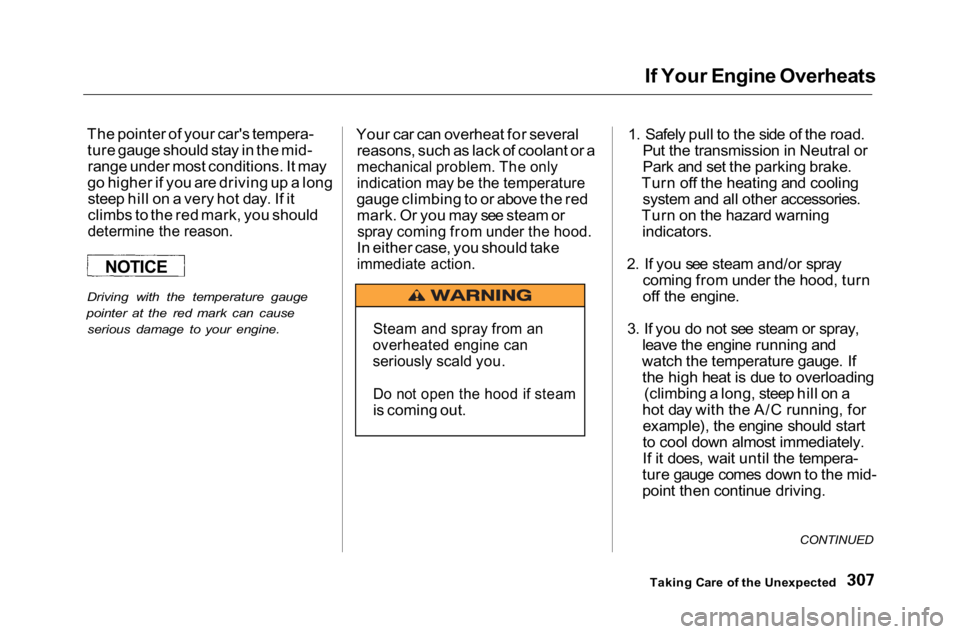
If Your Engine Overheats
The pointer of your car's tempera- ture gauge should stay in the mid-range under most conditions. It may
go higher if you are driving up a long steep hill on a very hot day. If it
climbs to the red mark, you should
determine the reason.
Driving with the temperature gauge
pointer at the red mark can cause serious damage to your engine.
Your car can overheat for several
reasons, such as lack of coolant or a
mechanical problem. The only
indication may be the temperature
gauge climbing to or above the red mark. Or you may see steam or
spray coming from under the hood.
In either case, you should take
immediate action.
1. Safely pull to the side of the road.
Put the transmission in Neutral or
Park and set the parking brake.
Turn off the heating and cooling system and all other accessories.
Turn on the hazard warning indicators.
2. If you see steam and/or spray coming from under the hood, turn
off the engine.
3. If you do not see steam or spray, leave the engine running and
watch the temperature gauge. If the high heat is due to overloading (climbing a long, steep hill on a
hot day with the A/C running, for example), the engine should start
to cool down almost immediately.
If it does, wait until the tempera-
ture gauge comes down to the mid-
point then continue driving.
CONTINUED
Taking Care of the Unexpected
Steam and spray from an
overheated engine can
seriously scald you.
Do not open the hood if steam
is coming out.
NOTICE